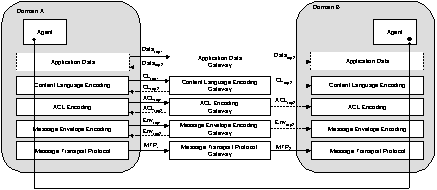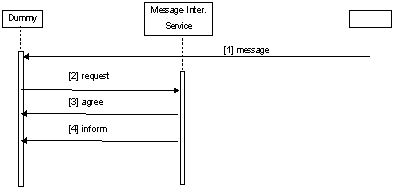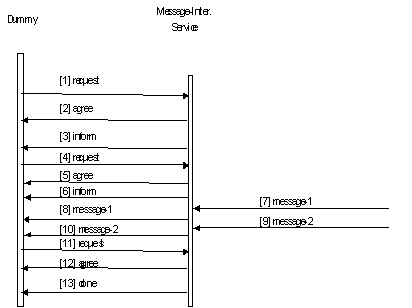1 Scope
This document is part of the FIPA specifications and deals with message conversion between inter-operating agents. This document also forms part of the FIPA Message Transport Service Specification [FIPA00067] and contains specification for:
· FIPA Message conversion between different Message Transport Protocols or/and concrete encoding.
The document provides a series of examples to illustrate the agent management functions defined.
2 Overview
The FIPA Messaging Interoperability Service (FIPA-MIS) provides a means for converting between Message Transport Protocols (MTPs) and between concrete encodings of FIPA-message parts. FIPA-MIS can be used where direct end-to-end interoperability is impossible, impractical or undesirable. Direct end-to-end interoperability is impossible when communicating platforms/agents do not support any common message transport protocol or encoding of FIPA-message components, for example. Direct end-to-end interoperability may be impractical when communicating over a slow wireless link with a peer in the fixed network that does not support any message transport protocol suitable for wireless links.
2.1 Reference Model
The reference model for FMIS comprises four levels (seeFigure 1):
1. The Message Transport Protocol Gateway (MTP-GW) is used to translate between Message Transport Protocols. For example, the Message Transport Protocol Gateway may translate between fipa.mts.mtp.iiop.std and fipa.mts.mtp.wap.std.
2. The Message Envelope Encoding Gateway (ENV-GW) is used to translate between Message Envelope encodings. For example, the Message Envelope Encoding Gateway may translate between fipa.mts.env.rep.xml.std and fipa.mts.env.rep.bitefficient.std.
3. The ACL Encoding Gateway (ACL-GW) is used to translate between ACL encodings. For example, the ACL Encoding Gateway may translate between fipa.acl.rep.xml.std and fipa.acl.rep.bitefficient.std.
4. The Content Language Encoding Gateway (CL-GW) is used to translate between Content Language encodings. Note that the current specification does not allow conversion between different content languages, only between different encodings of the same content language[1]. However, if this kind of functionality is needed, in can be added easily to the gateway specification. How such a translation is actually performed is an application implementation issue, and hence is out of scope.
The services specified here may also provide other kinds of translations (e.g., application dependent translation, etc.). This kind of functionality, however, should not be specified by FIPA, but hooks for such services exist in the specification.
|
Figure 1: FIPA Messaging Interoperability Service Reference Model |
3 FIPA Messaging Interoperability Service
3.1 Requesting a Translation Service
When an ACC (or another gateway) finds out that some or all parts of a message or a MTP must be converted to another, it must first find a messaging interoperability service that can perform the necessary translations (this process is not defined here). After this, the functions provided by the service can be used in order to translate between message components (i.e., content language, ACL, or envelope). If translation of message transport protocol is needed, the message can be sent to the service that provides MTP-GW. The service knows implicitly the target MTP by examining the transport address of the destination agent. For example, let’s assume that the agent-identifier of the destination agent is as follows:
(agent-identifier
:name foo@helluli.com
:addresses (sequence (wap://helluli.com http://helluli.com/acc)))
When receiving the message using the message transport protocol, for example IIOP, the MTP-GW translates the message transport protocol to WAP.
3.1.1 Receiver Initiated Translation Service
When an agent knows in advance that it is not able to receive messages encoded in a particular encoding, it may request the messaging interoperability service to automatically translate all the messages directed to it. The agent sends a description of the encoding it is able to understand to the FIPA-MIS, which will translate the message with the suggested encoding.
4 Messaging Interoperability Service Ontology
4.1 Object Descriptions
This section describes a set of frames, that represent the classes of objects in the domain of discourse within the framework of the FIPA-MIS ontology.
The following terms are used to describe the objects of the domain:
· Frame. This is the mandatory name of this entity, that must be used to represent each instance of this class.
· Ontology. This is the name of the ontology, whose domain of discourse includes the parameters described in the table.
· Parameter. This is the mandatory name of a parameter of this frame.
· Description. This is a natural language description of the semantics of each parameter.
· Presence. This indicates whether each parameter is mandatory or optional.
· Type. This is the type of the values of the parameter: Integer, Word, String, URL, Term, Set or Sequence.
· Reserved Values. This is a list of FIPA-defined constants that can assume values for this parameter.
4.1.1 Translation Identifier
This type of object represents the unique identification for the incoming message translation.
|
Frame Ontology |
translation-id FIPA-MIS |
|
||
|
Parameter |
Description |
Presence |
Type |
Reserved Values |
|
Id |
Unique identifier for the incoming message translation. The identifier is unique only in one Messaging Interoperability Service. |
Mandatory |
String |
|
4.2 Function Descriptions
The following tables define usage and semantics of the functions that are part of the FIPA-MIS ontology.
The following terms are used to describe the functions of the FIPA-MIS domain:
· Function. This is the symbol that identifies the function in the ontology.
· Ontology. This is the name of the ontology, whose domain of discourse includes the function described in the table.
· Supported by. This is the type of agent that supports this function.
· Description. This is a natural language description of the semantics of the function.
· Domain. This indicates the domain over which the function is defined. The arguments passed to the function must belong to the set identified by the domain.
· Range. This indicates the range to which the function maps the symbols of the domain. The result of the function is a symbol belonging to the set identified by the range.
· Arity. This indicates the number of arguments that a function takes. If a function can take an arbitrary number of arguments, then its arity is undefined.
4.2.1 Available Encodings
|
Function |
available-encodings |
|
|
Ontology |
FIPA-MIS |
|
|
Supported by |
fipa-mis |
|
|
Description |
An agent may query the service to provide a list of all encoding representations known by the service. |
|
|
Domain |
None |
|
|
Range |
gateway-description |
|
|
Arity |
0 |
|
4.2.2 Resolve Encoding
|
Function |
Resolve |
|
|
Ontology |
FIPA-MIS |
|
|
Supported by |
fipa-mis |
|
|
Description |
An agent may query the service to resolve the encoding with which the supplied message-component has been encoded. If the action is successful, the service will return the encoding-representation of supplied message-component. |
|
|
Domain |
message-component[2] |
|
|
Range |
encoding-representation |
|
|
Arity |
1 |
|
4.2.3 Transform Encoding
|
Function |
transform |
|
|
Ontology |
FIPA-MIS |
|
|
Supported by |
fipa-mis |
|
|
Description |
An agent may request the service to convert a transport-message or message component (i.e., payload, message, or content) into a particular encoding representation. The source message component is given as a parameter message-component and the encoding-representation parameter defines the target encoding. If the action is successful, the service will return the encoded message component. |
|
|
Domain |
||
|
Range |
message-component2 |
|
|
Arity |
2 |
|
4.2.4 Request Incoming Translation
|
Function |
incoming-translation |
|
|
Ontology |
FIPA-MIS |
|
|
Supported by |
fipa-mis |
|
|
Description |
An agent may request the service to convert automatically a transport-message or a message component (i.e., payload, message, or content) of an incoming message into a particular encoding representation before having it delivered. The preferred encoding is described in the gateway-behaviour. If the action is successful the service will return a translation-id, which can be used to cancel the translation service. |
|
|
Domain |
Sequence of gateway-behaviour(see [FIPA00067]) |
|
|
Range |
Translation-id |
|
|
Arity |
1 |
|
4.2.5 Cancel Incoming Translation
|
Function |
cancel-incoming-translation |
|
|
Ontology |
FIPA-MIS |
|
|
Supported by |
fipa-mis |
|
|
Description |
An agent may request the service to stop transforming messages before delivering them to the agent. |
|
|
Domain |
translation-id |
|
|
Range |
The execution of this function results in a change of the state, but it has no explicit result. Therefore there is no range set. |
|
|
Arity |
1 |
|
4.3 Exceptions
The exceptions for the FIPA-MISontology follow the same form and rules as specified in [FIPA00023].
4.3.1 Not Understood Exception Propositions
The same set of “Not Understood Exception Propositions” as in the FIPA-Agent-Managementontology is used in the FIPA-MIS ontology (see [FIPA00023]).
4.3.2 Refusal Exception Propositions
The same set of “Refusal Exception Propositions” as defined in the FIPA-Agent-Management ontology is used in FIPA-MISontology (see [FIPA00023]). In addition, the FIPA-MISontology defines the propositions given below.
|
Communicative Act Ontology |
refuse FIPA-MIS |
|
|
Predicate symbol |
Arguments |
Description |
|
Invalid-message |
|
The message component to be encoded is invalid in some way. |
|
Invalid-encoding |
|
The encoding-representation selected is unavailable. |
|
Unidentifiable-encoding |
|
The encoding-representation is unidentifiable by the service |
4.3.3 Failure Exception Propositions
|
Communicative Act Ontology |
failure FIPA-MIS |
|
|
Predicate symbol |
Arguments |
Description |
|
internal-error |
String |
See [FIPA00023]. |
|
|
|
|
|
unknown-identifier |
String |
The translation-id is unknown. |
5 Registration of a FIPA Messaging Interoperability Service with the DF
In order for a FIPA messaging interoperability service to advertise its willingness to provide its services to an agent domain, it must register with a DF (as described in [FIPA00023]).
As part of this registration process the following constant values are introduced that universally identify the services the agent provides:
· The type slot in the service-description frame of FIPA messaging interoperability service must be declared as a constant fipa-mis.
· The ontology slot in the service-description frame of FIPA messaging interoperability service must be declared as a constant FIPA-MIS.
Below is given an example content of an agent df-agent-description frame which provides the following functionality:
· translation service from XML encoded envelopes to bit-efficient envelopes, and
· translation service from XML encoded ACL messages to bit-efficient ACL messages.
(df-agent-description
:name
(agent-identifier
:name fipa-gateway@iiop://foo.com/acc
:addresses (sequence iiop://foo.com/acc))
:ontology (set FIPA-MIS)
:language (set fipa-sl0)
:services (set
(service-description
:name fipa-messaging-interoperability-service
:type fipa-mis
:ontology FIPA-MIS
:properties
(gateway-description
:acl-translation
(acl-gateway-description
:from
(encoding-representation :name fipa.acl.rep.xml.std)
:to
(set
(encoding-representation :name fipa.acl.rep.bitefficient.std)))
:envelope-translation
(envelope-gateway-description
:from
(encoding-representation :name fipa.mts.env.rep.xml.std)
:to
(set
(encoding-representation
:name fipa.mts.env.rep.bitefficient.std)))))
:ownership (set Helluli)))))
6 References
[FIPA00023] FIPA Agent Management Specification. Foundation for Intelligent Physical Agents, 2000. http://www.fipa.org/specs/fipa00023/
[FIPA00067] FIPA Agent Message Transport Service Specification. Foundation for Intelligent Physical Agents, 2000. http://www.fipa.org/specs/fipa00067/
7 Informative Annex A — Examples
7.1 Transformation Encoding Request
|
Figure 2: Transformation of message-component encoding
|
This example shows how an agent requests the Messaging Interoperability Service to transform a message component from one encoding to another. The message flow is illustrated in Figure 2.
1. Message [1]: The agent dummy receives a message and wants to transform the ACL-encoding of the message.
2. Message [2] request: The agent dummy sends the transform request to the Messaging Interoperability Service. The request contains the message-component to be transformed and the requested new encoding representation.
(request
:sender
(agent-identifier
:name dummy
:addresses (sequence http://helluli.com/acc))
:receiver (set
(agent-identifier
:name fipa-messaging-interoperability-service
:addresses (sequence http://fmis.com/acc)))
:ontology FIPA-MIS
:language fipa-sl0
:protocol fipa-request
:content
(action
(agent-identifier
:name fipa-messaging-interoperability-service)
(transform
(message-component (request …) )
(encoding-representation
:name fipa.acl.rep.bitefficient.std))))
3. Message [3] agree: The Messaging Interoperability Service agrees to perform the transformation:
(agree
:sender
(agent-identifier
:name fipa-messaging-interoperability-service
:addresses (sequence http://fmis.com/acc))
:receiver (set
(agent-identifier
:name dummy
:addresses (sequence http://helluli.com/acc)))
:ontology FIPA-MIS
:language fipa-sl0
:protocol fipa-request
:content
((action
(agent-identifier
:name fipa-messaging-interoperability-service)
(transform
(message-component (request …) )
(encoding-representation
:name fipa.acl.rep.bitefficient.std)))
true))
4. Message [4] inform: The Messaging Interoperability Service returns the encoded message component to the agent.
(inform
:sender
(agent-identifier
:name fipa-messaging-interoperability-service
:addresses (sequence http://fmis.com/acc))
:receiver (set
(agent-identifier
:name dummy
:addresses (sequence http://helluli.com/acc)))
:ontology FIPA-MIS
:language fipa-sl0
:protocol fipa-request
:content
(result
(action
(agent-identifier
:name fipa-messaging-interoperability-service)
(transform
(message-component (request …) )
(encoding-representation
:name fipa.acl.rep.bitefficient.std)))
(message-component 0xfa… )))
7.2 Resolve Encoding
This example shows how an agent requests the Messaging Interoperability Service to resolve the encoding of a message component.
1. Message [1] request: The agent dummy sends the resolve request to the Messaging Interoperability Service:
(request
:sender
(agent-identifier
:name dummy
:addresses (sequence http://helluli.com/acc))
:receiver (set
(agent-identifier
:name fipa-messaging-interoperability-service
:addresses (sequence http://fmis.com/acc)))
:ontology FIPA-MIS
:language fipa-sl0
:protocol fipa-request
:content
(action (agent-identifier :name fipa-messaging-interoperability-service)
(resolve
(message-component <fipa-message>…</fipa-message>))))
2. Message [2] agree: The Messaging Interoperability Service agrees to perform the action.
3. Message [3] inform: The Messaging Interoperability Service informs the agent dummy that the message is encoded using fipa.acl.rep.xml.std.
(inform
:sender
(agent-identifier
:name fipa-messaging-interoperability-service
:addresses (sequence http://fmis.com/acc))
:receiver (set
(agent-identifier
:name dummy
:addresses (sequence http://helluli.com/acc)))
:ontology FIPA-MIS
:language fipa-sl0
:protocol fipa-request
:content
(result
(action (agent-identifier :name fipa-messaging-interoperability-service)
(resolve
(message-component <fipa-message>…</fipa-message>)))
(encoding-representation
:name fipa.acl.rep.xml.std)))
7.3 Receiver initialised transformations
This example shows how an agent requests the Messaging Interoperability Service to transform messages before their delivery to the agent.
|
Figure 3: Receiver Initialised Transformations |
1. Message [1] request: The agent dummy query the Messaging Interoperability Service a list of all the encoding representations known by the service.
(request
:sender
(agent-identifier
:name dummy
:addresses (sequence http://campa.com/acc))
:receiver (set
(agent-identifier
:name fipa-messaging-interoperability-service
:addresses (sequence http://fmis.com/acc)))
:ontology FIPA-MIS
:language fipa-sl0
:protocol fipa-request
:content
(action
(agent-identifier
:name fipa-messaging-interoperability-service)
(available-encodings)))
2. Message [2] agree: The Messaging Interoperability Service agrees to deliver the list.
3. Message [3] inform: The Messaging Interoperability Service sends the list:
(inform
:sender
(agent-identifier
:name fipa-messaging-interoperability-service
:addresses (sequence http://fmis.com/acc))
:receiver (set
(agent-identifier
:name dummy
:addresses (sequence http://campa.com/acc)))
:ontology FIPA-MIS
:language fipa-sl0
:protocol fipa-request
:content
(result
(action
(agent-identifier
:name fipa-messaging-interoperability-service)
(available-encodings))
(gateway-description
:acl-translation
(set
(acl-gw-description
:from fipa.acl.rep.bitefficient.std
:to (set fipa.acl.rep.string.std fipa.acl.rep.xml.std))
(acl-gw-description
:from fipa.acl.rep.string.std
:to (set fipa.acl.rep.bitefficient.std))))))
4. Message [4] request: The agent dummy requests to the Messaging Interoperability Service to transform messages to the fipa.acl.rep.bitefficient.std encoding before delivering them to the agent dummy:
(request
:sender
(agent-identifier
:name dummy
:addresses (sequence http://campa.com/acc))
:receiver (set
(agent-identifier
:name fipa-messaging-interoperability-service
:addresses (sequence http://fmis.com/acc)))
:ontology FIPA-MIS
:language fipa-sl0
:protocol fipa-request
:content
(action (agent-identifier :name fipa-messaging-interoperability-service)
(incoming-translation
(sequence
(gateway-behaviour
:acl fipa.acl.rep.bitefficient.std)))))
5. Message [5] agree: The Messaging Interoperability Service agrees.
6. Message [6] inform: The Messaging Interoperability Service returns an translation identifier:
(inform
:sender
(agent-identifier
:name fipa-messaging-interoperability-service
:addresses (sequence http://fmis.com/acc))
:receiver (set
(agent-identifier
:name dummy
:addresses (sequence http://campa.com/acc)))
:ontology FIPA-MIS
:language fipa-sl0
:protocol fipa-request
:content
(result
(action (agent-identifier :name fipa-messaging-interoperability-service)
(incoming-translation
(sequence
(gateway-behaviour
:acl fipa.acl.rep.bitefficient.std))))
(translation-id :id id1)))
7. Message [7]: The service receives a message for dummy, and converts the ACL encoding to fipa.acl.rep.bitefficient.std.
8. Message [8]: The service delivers the message to the agent dummy.
9. Message [9] and Message [10]: Another message delivered to the agent dummy after being translated.
10. Message [11] request: The agent dummy sends a request to the Messaging Interoperability Service to cancel the translation of incoming messages:
(request
:sender
(agent-identifier
:name dummy
:addresses (sequence http://campa.com/acc))
:receiver (set
(agent-identifier
:name fipa-messaging-interoperability-service
:addresses (sequence http://fmis.com/acc)))
:ontology FIPA-MIS
:language fipa-sl0
:protocol fipa-request
:content
(action (agent-identifier :name fipa-messaging-interoperability-service)
(received-translated-cancel
(translation-id :id id1))))
11. Message [12] agree: The service agrees.
12. Message [13] inform: The service informs the agent that the translation of the incoming messages has been cancelled.


